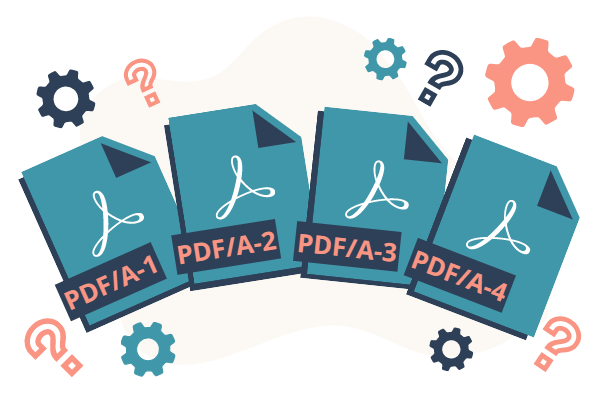Types of PDF/A

PDF/A was designed as a series of multi-part standards: PDF/A-1, PDF/A-2, PDF/A-3, and PDF/A-4. Newer published versions do not supersede or supersede earlier published versions in any way. For example, PDF/A-1 compliant documents that have been created will remain valid for long-term archiving. They can remain unchanged, so there is no need to “upgrade” to PDF/A-2.
There are different types of PDF/A as well as different properties. Each type has its own capabilities created by other standards and conformance levels. Each standard identifies the number of features available and image compression techniques that help archive the contents of a file.
Each standard has different conformance levels: a (accessible), b (basic), and u (unicode), depending on the standard itself. These conformance levels govern the accessibility requirements of a file, which affect the ability of humans and machines to understand its content.
Following are the four types of PDF/A
PDF/A-1
PDF/A-1 is the most commonly used original PDF/A format today. It is based on PDF 1.4 and is the most restrictive one as it does not support JPEG 2000, attachments, layers and transparency. Part 1 of the standard was first published on September 28, 2005, and specifies two levels of conformance for PDF files:
PDF/A-1b – Level B (basic) conformance
Level B conformance requires only those standards necessary to reliably reproduce the visual appearance of the document. This means that the file will look the same when viewed and/or printed in the near future or in future.
PDF/A-1a – Level A (accessible) conformance
Level A conformance includes all Level B requirements plus features designed to improve document accessibility by adding attributes that ensure documents are accessible to users with disabilities. It requires reliable Unicode text semantic and structural information to preserve the logical structure and natural reading order of the document.
PDF/A-2
Unlike its predecessor, this standard includes transparency, layers, JPEG 2000 and JBIG2 image compression, and attachments (PDF/A files only). Part 2 of the PDF/A Standard was published on June 20, 2011, addressing some of the new features added in PDF Reference versions 1.5, 1.6 and 1.7:
- JPEG 2000 image compression
- Supports transparency effects and layers
- Embed OpenType fonts
- Compliant with PDF Advanced Electronic Signature
- Option to embed PDF/A files
PDF/A-2 has three conformance levels: a, b, and u. Since we’ve already looked at a and b, let’s check the u level.
Conformance level U allows reliable searching and copying of documents where they do not conform to other levels requirements.
PDF/A-3
PDF/A-3 is a year younger than its predecessor and almost identical to it. This standard is also based on PDF 1 and has the same features as PDF/A-2. The only difference between the two standards is that PDF/A-3 allows appending any file format (such as XML, CSV, CAD, word processing documents, spreadsheet documents, and others) into a PDF/A compliant document, not just Only PDF/A files. However, this standard does not guarantee that you will be able to use or read attachments in the future.
PDF/A-4
Part 4 of the standard is based on PDF 2.0, which was released in 2020 and differs significantly from all previous standards.
First, it drops the three aforementioned consistency levels (a, b, and u) and introduces two new ones: e and f.
PDF/A-4e supports Rich Media, 3D annotations, and embedded files, while PDF/A-4f targets engineering documents. Another difference is that the standard allows JavaScript to be kept in the file. However, it must be stored in an embedded file stream and cannot be executed by the viewer.
In addition, the requirements related to the logical structure were removed and replaced by recommendations following the PDF/UA family of standards.
VP Online Free PDF converter supports converting documents to PDF/A in a few steps. Converting PDF to PDF/A online, easily, and free on VP Online Editor.

